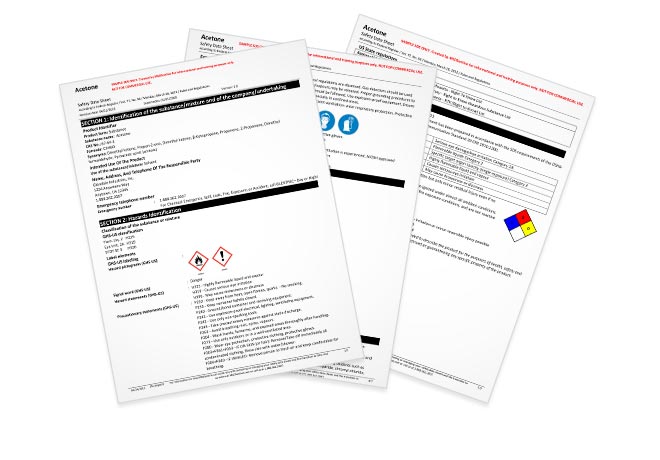Note: This blog was updated on September 20, 2024 to provide additional clarification.
The short answer is: “No, not quite.”
Many EHS professionals don’t realize that the “30-year” requirement is not actually in the HazCom standard. It’s found in a different standard, 1910.1020 on “Access to Employee Exposure and Medical Records.” A careful reading of OSHA Standard 29 CFR 1910.1020, and several letters of interpretation (LOIs) reveals that you are not technically required to keep safety data sheets (SDSs) or material safety data sheets (MSDSs) for 30 years.
You are required to keep some record of the identity of the substances or agents to which employees are exposed for 30 years. To that end, OSHA recognizes an SDS/MSDS as an acceptable record – and as you will see, SDS/MSDS retention may be your easiest recourse.
If you choose not to retain the actual SDSs/MSDSs, then OSHA requires you to have not only a record of the identity (chemical name if known) of the substance or agent, but also information regarding where and when it was used.
Again, if you do not keep the SDS/MSDS, then whatever record you do keep must include information about ‘where’ and ‘when’ the chemical or substance was used.
This seeming contradiction between what OSHA requires from an SDS/MSDS vs. other record types was pointed out in a Letter of Interpretation dated November 8, 1985. In it, OSHA explained that during the development of the rule, employers successfully objected to the inclusion of “where” and “when” on MSDSs. Yet, OSHA was successful in having that information be a requirement for those employers choosing an alternative method of record keeping.
The purpose of Standard 29 CFR 1910.1020, is “…to provide employees and their designated representatives a right of access to relevant exposure and medical records; and to provide representatives of the Assistant Secretary a right of access to these records in order to fulfill responsibilities under the Occupational Safety and Health Act.”
Under Standard 1910.1020, you are required to provide employees and former employees access to records. The standard reads, “If your employer cannot provide access to your records within fifteen working days, they must tell you the reason for the delay and the earliest date when your records can be made available.”
Of course, you shouldn’t see compliance with 1910.1020 as involving a choice between either maintaining copies of all SDSs/MSDSs for 30 years or maintaining a record of chemicals used, including the “when” and “where” details. Modern SDS management software makes it easy to do both of those things, and that’s what you should strongly consider doing. Having both an archive of SDSs/MSDSs and historical usage information gives you a better basis to accurately respond to potential claims by current or past employees asserting that chemical exposures in your workplace resulted in occupational illnesses.
What if an SDS/MSDS is superseded, perhaps because the chemical manufacturer changed the formulation? OSHA addressed this situation way back in a 1987 LOI, stating that employers may discard an MSDS/SDS if the new data sheet includes the same hazardous chemicals as the original formulation. If the employer is complying with 1910.1020 by retaining MSDSs/SDSs, and the new document indicates a different formulation compared to the original document, the LOI states that you should maintain both data sheets for at least 30 years.
You should note that your obligation to employees (and former employees) does not end if you sell your business or cease doing business before the 30-year window has expired; in such instances you are required to transfer all records either to the successor employer or to the Director of the National Institute for Occupational Safety and Health (NIOSH).
Your responsibilities under Standard 1910.1020 should not be confused with your obligations under Standard 1910.1200, which states that you must make SDSs/MSDSs readily accessible to employees during their work shift. Considering that your obligations under 1910.1200 require you to have SDSs/MSDSs, it might make sense just to keep those SDSs/MSDSs for compliance with 1910.1020.
A good electronic SDS/MSDS management tool can help keep you in compliance with both standards.
Let VelocityEHS Help!
Our VelocityEHS safety software makes it easy for you to maintain an updated SDS library that you and your people can access from anywhere 24/7 and is along with streamlined ability to manage other core safety tasks such as inspections (including ability to develop and implement tailored chemical storage location inspection checklists), safety meetings, incident investigations, and corrective actions management. You’ll also have a much easier time archiving your SDSs for long-term access.
If you need deeper insights into your chemical inventory, our chemical management software can help there, too. You’ll get chemical ingredient indexing capabilities that use machine learning to extract information on chemical ingredients from SDSs, cross-reference them against various regulatory lists such as EPA’s Extremely Hazardous Substances (EHSs) and Toxic Release Inventory (TRI) reportable chemicals, and provide a Levels of Concern (LoC) summary containing regulatory radar screen “hits” and other key information, including established Occupational Exposure Limits (OELs) you need to know when managing your indoor air sampling program. Even better, we are among the very first software companies on the market with SDS and chemical management capabilities aligned with OSHA’s 2024 final rule aligning the HazCom Standard with Revision 7 of the UN’s Globally Harmonized System of Classification and Labeling of Chemicals (GHS).
Contact us today to learn more about the ways we can help you maintain compliance with HazCom, or schedule a demo to see our software in action for yourself.
